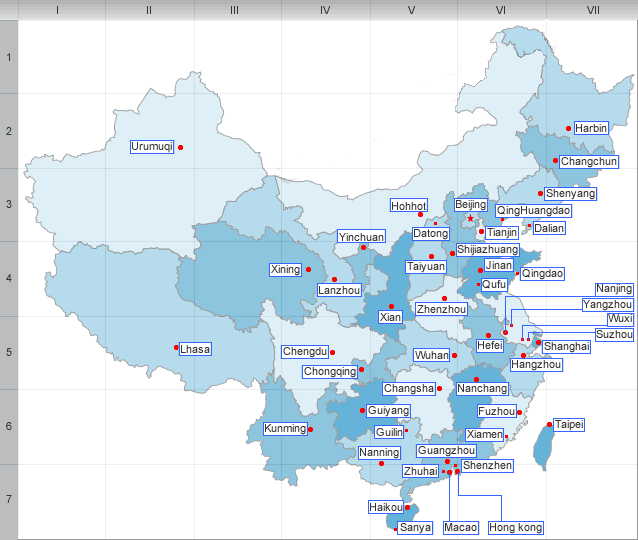Jiangyin Overview
Located on the southern bank of Yangtze River, Jiangyin City is a county-level city under the jurisdiction of Wuxi that is one of thirteen prefecture-level cities of Jiangsu Province. The land, nicknamed “Shade of River” in Chinese, has a history of human civilization more than 5,000 years, tracking back to the New Stone Age. In past 2,500 years, the ancient town had frenquent name changes along with the change of dynasties. Those used names include Donghai, Hailing, Wuling, etc.
Jiangyin City is under the jurisdiction of Wuxi. The city is comprised of 16 towns, one high-tech industrial park and a new port region. Its municipal government is stationed in the Town of Chenjiang. The best-known township, Huaxi Village, is one of townships of the city. Jiangyin has a land mass of 1,417 square kilometers and its water surface area occupies about 20% of the land. The city’s population is 1.2 million.
Jiangyin has been listed in several critical national rankings including the National Economic Comprehensive Strength, China’s Top 100 Counties (county-level cities), the Best Cities for Investment in Yangtze River Delta, the Best City for Science and Technology, the Best Hygienic City, etc.
Economy, Industry and Environment
Jiangyin is traditionally a farming land on the southern Jiangsu Plain and the agricultural income is the major portion of the city’s revenue. Its agricultural produces primarily include rice, wheat, cotton, rapeseeds, etc. Now the agricultural earning only occupies 1-2% of the total GDP of the city.
The rapid economic expansion and industrialization over the past decades has turned the city to a wealthy municipality and the industrial income is becoming the prominence. The industrial sectors have gained enormous investments from national and international enterprisers and have brought the city the new economic capacity. The joint industrial development has emerged in Jiangyin’s urban area, towns and rural communities and this coalition greatly increases the economic booming. Now Jiangyin is topped the list of China’s Top 100 Counties (county-level cities) in 2007 and several other national rankings referring to economy, hygiene, ecology, and more.
The so-called Chinese best and worthiest township, Huaxi Village, is located in Jiangyin City. The township has a population of thirty thousands and a physical size of around 30 square kilometers. The village is advocated by Chinese government as the model for prosperity and improvement of rural economy. Average income for residents in the township can reach $10,000 USD annually, the highest in all China’s rural economies.
The city was historically important as a major port on the Yangtze River. Its new port area enhances its capacity for waterway transportation. Waterway trade across the Pacific Ocean is traditionally important, carrying out since Tang Dynasty. The major trade partners include Japan, Korea and Southeast Asia.
Economic growth and environmental conservation have always seemed like two different approaches. As a sprawling metropolis, Jiangyin has experienced environment damage from its industrial sectors. The municipal government has been putting stiff environmental policies into practice over years. The city has spent $12.3 million in 2004 only to clean polluted rivers and to plant trees along its major roads. The city has also closed all mines to protect the nearby mountains from being overmined. More than 90% of companies in Jiangyin are noted as having significantly reduced its pollution since the environmental efforts were put into place. The city is listed as the best Chinese city in environment protection.
Transportation and Tourism
Jiangyin is linked by two major tranport systems: waterway and expressway/highway. The Wuxi-Chenjiang (Jiangyin municipal location) connects Jiangyin and Wuxi, and other four highways links the city, respectively, to Changzhou, Zhenjiang and Qingjiang.
The six-lane Jiangyin-Jingjiang Suspension Bridge, spanning the Yangtze and completed in 1999, links the south of Jiangsu to its northern side. The main span of the bridge is 1,385 meters long, making it the fifth longest bridge of its kind in the world. The bridge was designed with three traffic lanes in both directions and pedestrian sidewalks, carring the traffic from two busy national expressways: Tongjiang-Sanya Expressway, which connects the China’s east coast to its south part, and Beijing-Shanghai Expressway, which ties the China’s north with the east.
Xinchang Railway, connecting Xinyi City of Jiangsu to Changxing City of Zhejiang Province, passes Jiangyin, using ferries to cross the Yangtze River, linking another major railway, Jinghu Railway, Beijing to Shanghai.
Jiangyin is a waterway transport hub and Jiangying Port is a deep-water port positioned on Yangtze River and has been dubbed as a “golden coast line”. The port has attracted a large sum of capitals and has established waterway trade relations with more than 40 countries and regions.
In the inner city, the public transportation including bus, taxi and cargo transport, long distance buses to near cities or towns, provides convenience to the city’s commuters and visitors.
Jiangyin has numberous tourist attranctions including historical sites, parks and temples.
The most attractive site for tourists is about seeing Huaxi Village. Hundreds of tourist groups nationally or internationally flock to the village each day to see and learn about the village, including visiting local resident homes. The beautiful scenes and well-protected environment would touch you deeply.
Named with well-known adventurer Xu Xiake, China Xu Xiake International Traveling Festival was hosted in Jiangyin in May 2006.
Xuzheng Cultural Tourist Zone and Huangshan Lake Park are two 4-AAAA national tourist attractions. The former include many historical relics of old Jiangsu scholar and examination building, parks, walking street, temple, ect. Huangshan Lake Park is located on the southern shore of the lake and 35 hectares in size, which is actually a man-made lake.
Education
Jiangyin has well instituted compulsory primary education system. The secondary schools including high schools achieves significant graduate rate. Its adult vocational education system has brought diverse programs to its labor forces.
Culture and Folklore
Jiangyin Social Welfare Institute is the home for many adopted orphans who spent their early life there and later were adopted by families from the North America and Europe.
| PREV:Zhangjiagang Overview | Next:Wujiang Overview |



